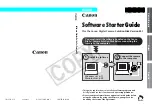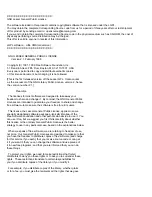
SNMP Trap Events
EPICenter Reference Guide
531
OSPF Originate LSA
An ospfOriginateLsa trap signifies that a new LSA has been
originated by this router. This trap should not be invoked for
simple refreshes of LSAs (which happens every 30 minutes),
but instead will only be invoked when an LSA is (re)originated
due to a topology change. Additionally, this trap does not
include LSAs that are being flushed because they have reached
MaxAge.
ExtremeWare 6.1.9
ExtremeXOS 10.1
OSPF TX_Retransmit
An ospfTxRetransmit trap signifies than an OSPF packet has
been retransmitted on a non- virtual interface. All packets that
may be retransmitted are associated with an LSDB entry. The
LS type, LS ID, and Router ID are used to identify the LSDB
entry.
ExtremeWare 6.1.9
ExtremeXOS 10.1
OSPF Virtual Interface
Authentication Failure
An ospfVirtIfAuthFailure trap signifies that a packet has been
received on a virtual interface from a router whose
authentication key or authentication type conflicts with this
router’s authentication key or authentication type.
ExtremeWare 6.1.9
ExtremeXOS 10.1
OSPF Virtual Interface
Config Error
An ospfVirtIfConfigError trap signifies that a packet has been
received on a virtual interface from a router whose configuration
parameters conflict with this router’s configuration parameters.
Note that the event optionMismatch should cause a trap only if
it prevents an adjacency from forming.
ExtremeWare 6.1.9
ExtremeXOS 10.1
OSPF Virtual Interface
Receive Bad Packet
An ospfVirtIfRxBadPacket trap signifies that an OSPF packet
has been received on a virtual interface that cannot be parsed.
ExtremeWare 6.1.9
ExtremeXOS 10.1
OSPF Virtual Interface
State Change
An ospfVirtIfStateChange trap signifies that there has been a
change in the state of an OSPF virtual interface. This trap
should be generated when the interface state regresses (e.g.,
goes from Point- to-Point to Down) or progresses to a terminal
state (i.e., Point-to-Point).
ExtremeWare 6.1.9
ExtremeXOS 10.1
OSPF Virtual Interface
TX Retransmit
An ospfVirtIfTxRetransmit trap signifies than an OSPF packet
has been retransmitted on a virtual interface. All packets that
may be retransmitted are associated with an LSDB entry. The
LS type, LS ID, and Router ID are used to identify the LSDB
entry.
ExtremeWare 6.1.9
ExtremeXOS 10.1
OSPF Virtual Neighbor
State Change
An ospfVirtNbrStateChange trap signifies that there has been a
change in the state of an OSPF virtual neighbor. This trap
should be generated when the neighbor state regresses (e.g.,
goes from Attempt or Full to 1-Way or Down) or progresses to a
terminal state (e.g., Full).
ExtremeWare 6.1.9
ExtremeXOS 10.1
Overheat
Extreme Networks proprietary trap. Indicates the on board
temperature sensor has reported an overheat condition. This
indicates the temperature has reached the Overheat threshold.
The switch will continue to function until it reaches its
shutdown threshold. The system will then shutdown until the
unit has sufficiently cooled such that operation may begin
again. A cold start trap will be issued when the unit has come
back on line. This trap is sent repetitively every 30 seconds
until the temperature goes back to normal.
All
Ping Probe Failed
Generated when a probe failure is detected when the
corresponding pingCtlTrapGeneration object is set to
probeFailure(0) subject to the value of
pingCtlTrapProbeFailureFilter. The object
pingCtlTrapProbeFailureFilter can be used to specify the
number of successive probe failures that are required before
this notification can be generated.
ExtremeWare 6.1.9
Not supported in
ExtremeXOS
Table 58: SNMP Trap Events (continued)
Event
Definition
ExtremeWare/
ExtremeXOS
Version
Summary of Contents for EPICenter 6.0
Page 14: ...EPICenter Reference Guide 14 ...
Page 18: ...Preface EPICenter Reference Guide 18 ...
Page 19: ...1 EPICenter Basic Features ...
Page 20: ......
Page 24: ...EPICenter Overview EPICenter Reference Guide 24 ...
Page 44: ...Getting Started with EPICenter EPICenter Reference Guide 44 ...
Page 100: ...The Inventory Manager EPICenter Reference Guide 100 ...
Page 140: ...The EPICenter Alarm System EPICenter Reference Guide 140 ...
Page 172: ...Configuration Manager EPICenter Reference Guide 172 ...
Page 196: ...The Firmware Manager EPICenter Reference Guide 196 ...
Page 220: ...The Interactive Telnet Feature EPICenter Reference Guide 220 ...
Page 250: ...The Grouping Manager EPICenter Reference Guide 250 ...
Page 276: ...Real Time Statistics EPICenter Reference Guide 276 ...
Page 342: ...Using the VLAN Manager EPICenter Reference Guide 342 ...
Page 348: ...The ESRP Monitor EPICenter Reference Guide 348 ...
Page 446: ...EPICenter Reports EPICenter Reference Guide 446 ...
Page 447: ...2 Advanced Upgrade Features ...
Page 448: ......
Page 480: ...EAPS Protocol Monitoring and Verification EPICenter Reference Guide 480 ...
Page 508: ...Using the Policy Manager EPICenter Reference Guide 508 ...
Page 525: ...3 Appendices ...
Page 526: ......
Page 542: ...EPICenter Backup EPICenter Reference Guide 542 ...
Page 564: ...Voice over IP Manager EPICenter Reference Guide 564 ...
Page 580: ...EPICenter Reference Guide 580 ...
















































